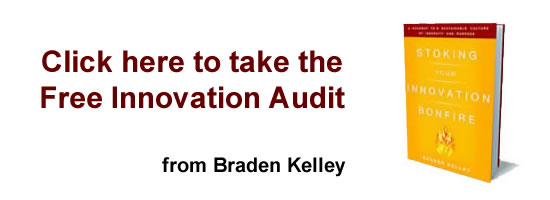If You Don’t Explore, You Won’t Invent And You Will Be Disrupted

As a manager, I always felt incredible pressure to innovate. Yet it was hard to know how to go about it. There were plenty of books about high flying companies, but those same organizations seemed to sputter out almost as soon as the ink was dry. I wanted to know how to innovate consistently, not just fly high and then flame out.
That’s what started me on the journey that led to my book, Mapping Innovation. Over the last decade, I’ve talked to hundreds of executives, entrepreneurs and scientists looking for what they had in common. What I found surprised me and has changed the way I look at innovation ever since.
The organizations I studied were all very different. Some were hard-charging, others fairly conservative. Some were centralized, others decentralized. Some innovators were charismatic, but others were soft-spoken and introspective. Yet the one thing they all had in common was their willingness to explore and that, it seems, is what makes all the difference.
How GE Got Disrupted
General Electric has earned its reputation as one of the world’s best managed companies. Its former CEO, Jack Welch, was named Manager of the Century by Fortune magazine, its executives are heavily recruited to run other companies and its management development campus at Crotonville is legendary.
Jeffrey Immelt’s tenure as CEO was very much in this vein. He deftly moved the company out of financial services and likely avoided the worst of the financial crisis. Much as Welch pioneered Six Sigma, he brought in lean startup guru  Eric Ries to implement a more entrepreneurial approach and created the FastWorks program to drive these methods throughout the company.
These were thoughtful, strategic moves designed to leverage the company’s existing strengths. In its power generation business, long a cash cow, the FastWorks program dramatically cut development times and improved quality. GE also acquired the power division of Alstom, in a move analysts called “brilliant” and the firm’s “best deal in a century.”
Unfortunately, while this strategy did much to improve the operational performance of the Power division, it did nothing to change the fact that, because of the rise of renewable energy, customers stopped buying gas powered generators. The company announced massive layoffs and Immelt was forced out. GE had become a square-peg business in a round-hole world.
Why IBM Never Died
Unlike GE, IBM has long been considered a dinosaur. It dominated the market for tabulating machines in the middle of the 20th century, but saw its business disrupted by digital computers and only a $5 billion gamble (more than $30 billion in today’s dollars) saved it from irrelevance. It then dominated mainframes for 20 years until that business got disrupted by minicomputers. It saved itself by pioneering PC’s, but even then Intel and Microsoft took the bulk of the profits.
More recently the company has seen its core business for installed systems get disrupted by the cloud. Once again, it seemed flat-footed compared to more agile competitors like Amazon and Google. IBM has, in fact, been disrupted with such metronomic regularity that it’s almost a wonder that it is even in business any more.
Yet strangely, IBM seems to have a bright future. Its Watson system pioneered artificial intelligence for the enterprise. As the end of Moore’s law is disrupting competitors like Intel, it is at the forefront of new computing architectures like quantum computing and neuromorphic chips. The company also seems to be turning a corner financially.
The fundamental difference between the two companies is that IBM invests consistently in exploring new technologies and searches widely for new problems to solve. At the same time, it’s hard to think of anything GE has invented since CT scanners in the 1970s, which makes it vulnerable. Essentially, IBM assumes it will be disrupted, while for GE to prosper it has to get every move right.
Make no mistake. Nobody gets every move right. Every business is disrupted eventually. It’s just a matter of time.
The Optimization Trap
Efficiency was the mantra of the 20th century and, for the most part, it served us well. Great enterprises “reinvent†their business by “streamlining†their organizations and adopting methodologies such as Six Sigma and TQM. Politicians vow to “root out waste, fraud and abuse†from our public institutions in the neverending quest to do more with less.
These are, in large part, worthy pursuits. If you don’t continually improve your processes and practices, you will eventually get left behind by your competition, who will be able to make products and services better and cheaper than you can. However — and this is a crucial point — it won’t help you do anything new.
There is a fundamental tradeoff between innovation and optimization and that’s a big part of GE’s problem today. It continued to get better and better at building gas powered generators its customers wanted less and less, while at the same time, it failed to establish truly new businesses.
That’s the efficiency paradox. By driving so hard to improve on existing metrics, we often fail to see how the future will be different. That makes it hard to adapt when the world changes and, perhaps even more importantly, it makes it harder to explore the unknown and discover new things that can help us create new markets.
Pursuing Grand Challenges
One of the things that I was searching for while researching my book was some commonality between the incredibly diverse group of innovators I came across. What could tie together this potpourri on extroverts, introverts, scientists, entrepreneurs, thrill seekers and staid corporate executives?
What I found was that all great innovators actively seek out new problems to solve. In other words, they not only continue to hone their existing processes and practices, they go actively look for areas where they can make an impact. These are, by definition, highly speculative and hard to predict, with lost of blind alleys and wrong turns, but they pay off in the end.
The most important type of problem for creating long term value is a grand challenge. These are not “bet the company†type of propositions, but sustainable, long-term efforts to solve a fundamental problem. Their impact is not measured in weeks or months, but years and decades. Nevertheless, they are the closest thing you’ll find to a sure thing.
The truth is that innovation needs exploration and that’s never efficient nor can it be optimized, but it can be done cheaply enough to be sustainable. For large enterprises like GE and IBM, that usually means investing in labs, but there are a number of ways even small business can access world class research.
Today we need to manage not for stability, but for disruption. So instead of just planning against established metrics, we also need to continually ask what we’re doing to explore the unknown. Not all who wander are lost.
An earlier version of this article first appeared in Inc.com
Image credit: Huawei
Wait! Before you go…
Choose how you want the latest innovation content delivered to you:
- Daily — RSS Feed — Email — Twitter — Facebook — Linkedin Today
- Weekly — Email Newsletter — Free Magazine — Linkedin Group
 Greg Satell is a popular author, speaker, and innovation adviser who has managed market-leading businesses and overseen the development of dozens of pathbreaking products. Follow Greg on Twitter @DigitalTonto. His first book, Mapping Innovation, was selected as one of the best business books of 2017 by 800-CEO-READ.
Greg Satell is a popular author, speaker, and innovation adviser who has managed market-leading businesses and overseen the development of dozens of pathbreaking products. Follow Greg on Twitter @DigitalTonto. His first book, Mapping Innovation, was selected as one of the best business books of 2017 by 800-CEO-READ.
NEVER MISS ANOTHER NEWSLETTER!
LATEST BLOGS
The Incredible Shrinking Laptop
As technology advances and people’s demands for ever-thinner, ever-lighter laptops increase, more and more the thickness of a laptop is…
Read MoreA Revolution in Management Consulting?
Management consulting firms are built on a model that requires the maintenance of a bench of their people to staff…
Read More



